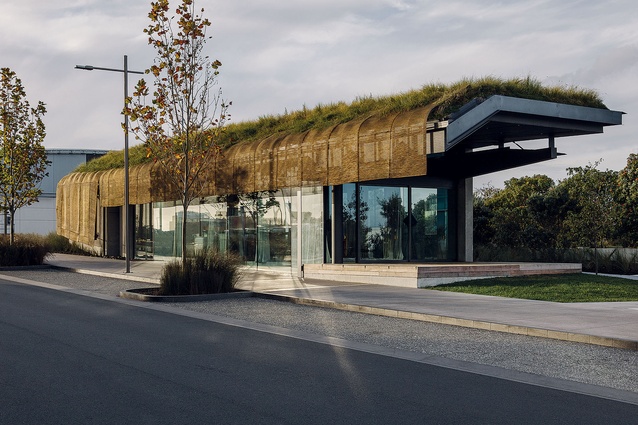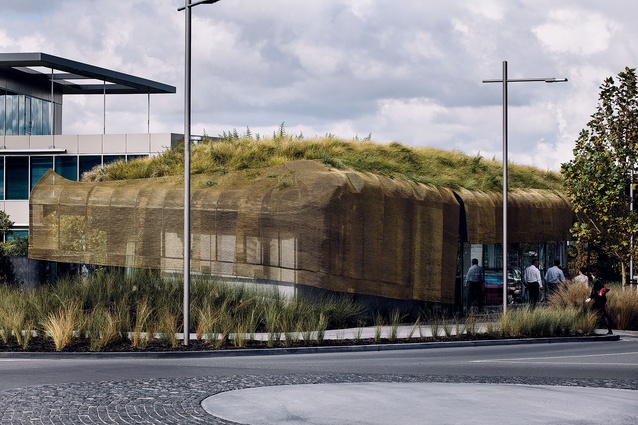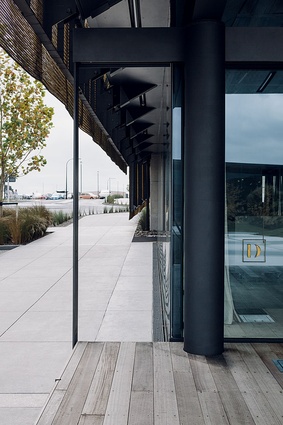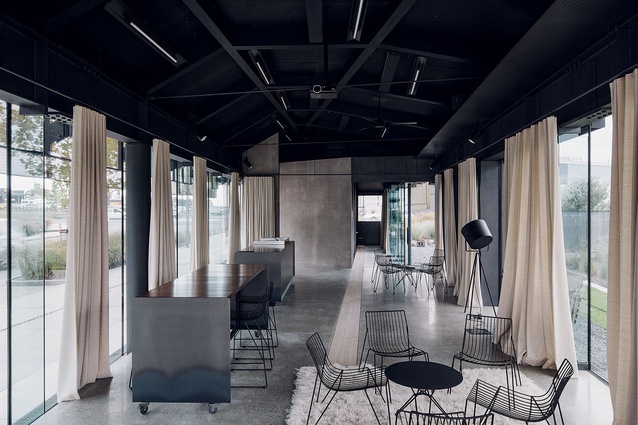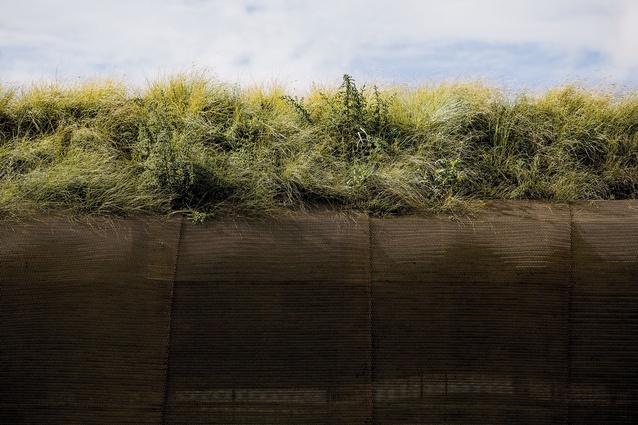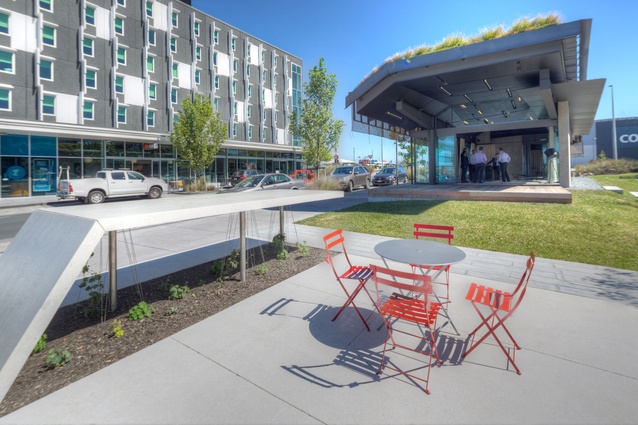Te Kaitaka - The Cloak
Fearon Hay Architects’ playful new marketing suite at Auckland Airport is a declaration of intent: a topographical, environmental and cultural response to its site on the Manukau Harbour.
The car journey to Auckland Airport is somewhat bizarre. Populating the roadside along George Bolt Memorial Drive are diagonal mounds of earth, up to nearly 9m high, covered in coal-coloured gravel and tufts of native planting. Boxy concrete and glass warehouses and headquarters frequent the landscape around here. If you happen to digress onto John Goulter Drive, what appears is your typical featureless shopping precinct – fronted, of course, by row upon row of car parks. You might as well be in any small New Zealand city, or typical English or American town, with the same old boring boxes – big yawn and sigh. Welcome to Aotearoa/New Zealand…
But look across the road from the car park into The Quad precinct and you will notice that a rare species has arisen from among the weeds. This new curvaceously formed building has the character that, perhaps, the gravel dunescape might have gained, if it weren’t blocking out distant views and displaying a distinct monotony that is rarely enjoyable from the ground (although it may be more interesting from the air).
Fearon Hay Architects’ design for a new property sales and marketing suite for Auckland Airport is a brave new offering that is already wowing prospective clients and passers-by – from the ground. Sited on a corner which was stolen back from in front of an existing building to realign the road, Te Kaitaka, aka ‘The Cloak’, appears to be the only building in the area to truly respond to the local environment and ecology, to address the public at street level, to contain its mass in a well-mannered way and to strike an emotional chord – with me, at any rate. It feels like a New Zealand building should feel. A living green canopy of native plants sprouts from the contoured roof, camouflaging and tying the form into the surrounding natural landscape of coastal flaxes and grasses. Somehow it’s weirdly comforting – familiar yet unfamiliar at once.
Fearon Hay Architects worked closely with the airport’s iwi relations manager Charles Berryman and his daughter Taina to marry its design with a Mãori world view. For Mãori, Te Kaitaka symbolises a prestigious cloak, rather than the more commonly known korowai, which superseded kaitaka as the cloak of choice during the 1890s. Te Kaitaka ‘the building’ is clothed in gleaming brass mesh that is irregularly overlapped from the main entrance outwards, much the same as a cloak would sit on its wearer. In Mãori Art & Culture, the late Mick Pendergrast, an eminent Mãori weaving expert, described te kaitaka ‘the cloak’ as “plain; their [its] beauty derived from the perfection of the weaving and the glossy appearance of the soft, pliable fibre”. It seems fitting, therefore, that the brass mesh, when viewed in sunlight, possesses the golden sheen of the woven harakeke flax of which the original cloaks were constructed. The sheen of the brass and the rooftop foliage create some delicate movement in response to the sun and wind, respectively, making the building display the kinetic character of cloth worn on the body.
This architecture of the ‘woven’ is a nod to traditional Mãori raupo buildings which once frequented Aotearoa until British colonists encouraged wooden constructions. Deidre Brown, in her paper Clothed not Clad: Mãori Woven Architecture, suggested that: “The decline in Māori thatch construction in the late 19th century was the result of social campaigns by Pakeha commentators against traditional Mãori living, and also changing attitudes towards ‘impermanent’ and ‘feminising’ building materials”. This is important on a number of levels and, in my opinion, if the built form of Te Kaitaka were to inherit the spirit of the tupuna (or ancestors) as a Mãori building, it would most certainly be the spirit of women. Unlike the buildings around her, Te Kaitaka possesses a femininity that seems at odds with the local architecture or even architecture more generally: perhaps, because cloak-making is predominantly a women’s art or, perhaps, due to its shapely form, or the scale, or the many layers – starting from the outer mesh envelope and layering back into the glazing and the LVL structure, and the folding drape of the curtains which line the interior. (Funnily enough, you don’t see many curtains hanging down within architectural projects, least of all commercial buildings, but Fearon Hay certainly knows how to make a sexy curtain – creating that sense of intimacy you’d expect to find in a boudoir, rather than a marketing suite. It’s that familial aspect again).
Once the building’s marketing duties are over, which is expected to be in 30 years’ time, it is designed to be converted easily into a café. It’s a shame the public will have to wait that long to enjoy coffee and korero within and around this building.
But Te Kaitaka’s surrounding area is a rapidly growing urban environment and Auckland Airport seems committed to developing a strong community out here; already it has been upgrading streets with trees and cobblestones, creating more pedestrian-focused areas, cycle lanes, a landscaped local park with a soccer pitch, a mountain-bike trail, etc. You can imagine that, with considerable and thoughtful effort, the area could be a destination for transit passengers, local workers and, in fact, any visitor. Here’s hoping the airport continues the precedent set by Te Kaitaka and focuses on commissioning more exciting new New Zealand architecture.
—>

